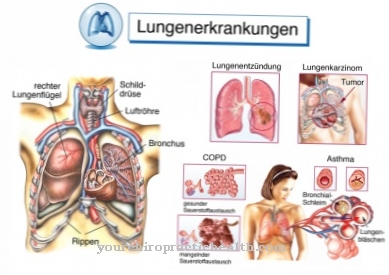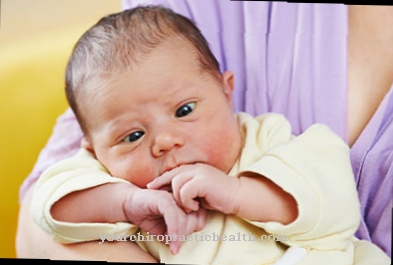In the autumn and winter months, children constantly catch colds. However, if there is pronounced shortness of breath and a clear feeling of exhaustion, one should be excluded RS infection the pediatrician must be consulted immediately. This is especially true for babies and toddlers.
What is RS virus infection?

© Köpenicker - stock.adobe.com
The Respiratory Syncytial Virus (RS virus) spreads via droplet or smear infection and causes severe cold and respiratory problems, especially in babies and children up to the age of two.
This manifests itself in a cough and runny nose with a high fever. The virus can spread to the bronchi and cause bronchitis, pneumonia or bronchiolitis there. This disease causes the mucous membrane of the bronchi to swell and leads to severe breathing difficulties.
Noticeably rapid and superficial breathing are also signs of shortness of breath. The lips and fingernails may be discolored bluish due to insufficient oxygen saturation in the blood. The RS virus usually occurs in the winter months and spring. Older children and adults have less pronounced symptoms when infected with the RS virus and are usually only slightly ill.
causes
The causative agents of RS virus infection are viruses that spread particularly in the months of September to April. They are passed on through smear or droplet infections in daily dealings with babies or toddlers and are highly contagious. Since the first signs of illness show up late, practically every contact person for a child can become an ignorant carrier.
There are around two to eight days between infection and the onset of the disease. Children whose immune system is still weakened as a result of an illness that has just been overcome, as well as premature babies, are particularly susceptible to RS infection.
Symptoms, ailments & signs
Children in the first year of life often get an RS virus infection. A permanent formation of antibodies does not take place. Therefore, the immune system is not prepared against reinfections in the following years. The upper and lower airways are affected by the inflammatory disease.
Throat, mouth and nose, but also bronchi or the lungs are part of it. Doctors refer to bronchial outbreaks as RSV bronchiolitis. The first symptoms appear after about three days of incubation. Increased body temperature and difficulty breathing are the main characteristic features. In addition to an accelerated breathing rate with rattling noises, a cough with slimy sputum accompanies the disease.
Sometimes those affected find it extremely difficult to breathe. Children can also develop strong coughing fits similar to whooping cough. The high loss of fluid also manifests itself as dry, hypothermic and colorless skin. Newborns sometimes have a sunken fontanel. The rest of the symptoms are similar to those of the flu, with a general feeling of illness, tiredness and a low need to drink and eat.
The severity of the infection tends to be reduced in adults. Nevertheless, the spectrum of complaints remains very variable. Extremely mild cases in otherwise healthy patients are also known as silent RSV infections. Otherwise runny nose, dry cough and sore throat dominate the clinical picture.
Severe spreads are still possible, but remain relatively rare. A special and dangerous unique selling point primarily puts the life of premature babies at risk: the RS virus tends to increase breathing to interruptions or even to a complete standstill.
Diagnosis & course
There one RS virus infection is particularly dangerous for babies and toddlers, a pediatrician must be consulted immediately in the event of a cold that is accompanied by massive breathing problems. This is especially the case if the child shows significantly poorer drinking behavior.
The doctor can rule out this dangerous infection by doing a blood test. In the case of a severe course with impairment of the airways, it is necessary to admit the child to the hospital in order to ensure constant monitoring of the respiratory function.
In addition to the RS virus infection, there is often an infection with bacteria, which can be life-threatening, so that ventilation is necessary. To prevent dehydration (dehydration), a nasogastric tube is placed in this case to ensure an adequate supply of nutrients.
Complications
RS virus infection can lead to serious complications in some people at risk. The risk is particularly high in newborns and babies in the first year of life. Infants and toddlers always have a fever up to a temperature of 38 to 39.5 degrees. Furthermore, infants suffer from coughs, breathing difficulties and runny nose.
The breathing difficulties often also cause poor drinking, which can lead to dehydration. Young children are also at risk of developing acute bronchiolitis. This leads to severe shortness of breath, which can even be fatal. The affected children must be adequately supplied with oxygen through an oxygen mask. Parenteral nutrition is carried out so that the airways are not irritated by possible aspiration of food residues.
Otherwise there is a risk of superinfections with bacteria, which can even be fatal. Pseudo croup develops as a complication in around five percent of children. Infants are even at risk of sudden infant death syndrome. Premature babies and children with cystic fibrosis or heart and lung diseases are particularly at risk. However, RS virus infection is not unique to infants and young children.
All other age groups can also be affected. In adulthood, the disease is usually mild or even symptom-free. However, there are high-risk patients who can experience serious complications. These risk groups include people who suffer from cardiovascular diseases, immunocompromised people or people with Down's syndrome.
Treatment & Therapy
Treatment of the RS virus depends on the symptoms that occur. In mild cases, the administration of nasal sprays and medication to dilate the bronchi and to liquefy the mucus can help relieve breathing difficulties.
Inhaling a saline solution is also helpful, but must always be done with the necessary caution and under supervision in babies and toddlers. It is important to offer the child enough to drink during the illness and not to lie completely flat in bed. A pillow in the back area makes breathing easier. Often, however, babies under six months of age are admitted to hospital because they are more likely to develop severe disease.
In the hospital, they can receive additional oxygen or, in an emergency, be given short-term ventilation. The use of antibiotics is only relevant if there has been an additional infection with bacteria, as these drugs have no effect on viral diseases such as the RS virus infection.
prevention
There is currently no vaccination against that RS virus infectionaccessible to all children. For reasons of cost, only children from special risk groups can be vaccinated. In addition to the cost aspect, this immunization is also very expensive since it has to be repeated monthly.
To prevent infection, all contact persons for babies and young children should ensure adequate hand hygiene. These should be washed with warm water and soap for at least one minute. If the parents have a cold, contact should be restricted. It is also recommended that you wear a face mask to avoid RS virus infection.
Aftercare
The RS virus is transmitted from person to person by droplet or smear infection. There is no direct therapy or chemoprophylaxis against these viruses; only the symptoms can be treated. Passive immunization with monoclonal antibodies is only recommended for high-risk patients such as premature babies, people with a previous pulmonary or cardinal disease, or immunocompromised patients.
The protective effect begins after the first vaccination dose, but does not reach the full maximum effect until after the second dose administered. Since the disease can reappear even after an infection, strict hygiene regulations should be observed for aftercare, especially for groups at risk. These include: frequent hand washing, coughing and sneezing not in the hands but in the elbow. People suffering from the virus should avoid communal facilities during the infectious period and regularly clean and disinfect used objects, such as toys.
The generally recommended vaccination status should also be checked and, if necessary, refreshed in order to avoid further complications such as co-infections. Since the RS virus infection mostly affects the bronchial system, the symptoms of the so-called hyperresponsive bronchial system can remain even after the disease has subsided. This in turn increases the risk of developing asthma. Therapy is therefore also aimed at suppressing this complex of symptoms using anti-inflammatory and / or bronchodilator drugs.
You can do that yourself
Infants and children affected by RS virus infection must seek medical attention. The younger the child, the more dangerous the infection can be. If a severe course of the disease is expected, the parents should take their child to a hospital, where they can be supplied with fluids and oxygen if necessary. The Respiratory Syncytial Virus (RS virus) is highly contagious and can infect anyone, including adults. Like most viral infections, it can only be treated symptomatically. This means that the individual symptoms such as sore throat, cough, runny nose, bronchitis and fever should be alleviated accordingly.
In the case of a mild course of the disease, a nasal spray is sufficient to allow the mucous membranes of the nose to swell. If the disease gets more severe, the doctor will recommend drugs that liquefy phlegm and help you cough up. It is important that the patient drinks a lot. Chicken soup is also recommended here. It warms from the inside and its hot steam moisturizes the mucous membranes. The soup also contains cysteine, a protein that has an anti-inflammatory and decongestant effect. Calf wraps are a gentle way to lower the temperature because cold wraps remove heat from the body. Table salt or chamomile inhalations have also proven their worth. The hot steam frees the nose and soothes irritated mucous membranes.
Since RS virus infection is often associated with shortness of breath, it is advisable to slightly elevate the patient. That makes breathing easier.


.jpg)





















.jpg)



